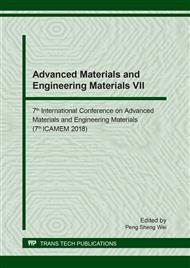[1]
Shinji Urano, Hirokazu Tanaka, Takashi Fujii, Toshiki, Ayano:Effect of Blast Furnace Slag Sand to Fresh Concrete Properties, Annual Conference on Civil Engineering Society, Vol.39, No.1, pp.1267-1272, (2017).
Google Scholar
[2]
Japan Society of Civil Engineers: Formulation Specification for Concrete Established in 2012 [Construction Edition], (2012).
Google Scholar
[3]
Civil Engineering Society: Concrete Technology Series 102, Inspection and Inspection System for Concrete Construction Performance Report Subcommittee Second Phase Committee Report, 2013.11.
Google Scholar
[4]
Shigeyuki Date, Yuji Ito, Satoshi Hasegawa, Yukikazu Tsuji: Effects of Partitioning and Mixing on Freshness under Mortar Vibration, Concrete Engineering Annual Proceedings, Vol.28, No.1, pp.1091-1096, 2006.6.
Google Scholar
[5]
Liangshun, Katsuro Kokufu, Kimitaka Uji, Atsushi Ueno: Study on the compaction property test method of fresh concrete, papers of the Japan Society of Civil Engineers E, Vol.62 No.2, pp.416-427, 2006.6.
Google Scholar
[6]
Takuya Saito, Masato Ogaki, Yusuke Fujikura, Shigeyuki Date: Basic Study on Rheological Properties and Filling Performance of Mortar Under Different Frequency Vibration, Concrete Engineering Annual Papers Collection, Vol.38, No.1, pp.1353-1358, (2016).
Google Scholar
[7]
Yusuke Fujikura: Fundamental Study on the Influence of Rheological Characteristics on Stillness and Vibration of Concrete on Filling Performance, Fujita Technical Research Report No.51, pp.21-26, (2015).
Google Scholar
[8]
Hirotsugu Mori, Yasuo Tanigawa: Flow analysis method of fresh concrete subjected to vibration force, Report of the structural review paper of the Japanese Architectural Institute, 388, pp.18-26, 1988.6.
Google Scholar
[9]
Takuya Saito, Yusuke Fujikura, Shin-ichiro Hashimoto, Shigeyuki Date: Basic research on rheological properties under static and vibration of mortar, Concrete engineering annual paper, Vol.37, No.1, pp.1099-1104, (2015).
Google Scholar
[10]
Takuya Saito, Yusuke Fujikura, Shin-ichiro Hashimoto and Shigeyuki Date: Study on the Rheological Properties of Fresh Mortar under Vibration,, International Journal of Structural and Civil Engineering Research Vol.4, No.3, pp.291-295, 2015.8.
DOI: 10.18178/ijscer.4.3.291-295
Google Scholar
[11]
Daiki Takehisa, Ichio Ide, Shin-ichiro Hashimoto, Shigeyuki Date: Fundamental study on improving compaction performance of concrete under vibration, Concrete engineering annual paper, Vol.39, No.1, pp.1273-1278, (2017).
Google Scholar
[12]
Daiki Takehisa, Ichio Ide, Shin-ichiro Hashimoto, Shigeyuki Date: Study on Improvement of Vibration Compaction Performance of Fresh Mortar, International Journal of Structural and Civil Engineering Research Vol.7, No.1, 2018.2.
DOI: 10.18178/ijscer.7.1.40-45
Google Scholar
[13]
Yoichiro Muroga, Shigeyuki Date, Tetsuo Osuga: Development of a viscousness evaluation test apparatus for mortar, Annual Conference on Civil Engineering Society, Vol.55, Department 5, V-406, 2000.9.
Google Scholar
[14]
Yoshiaki Yoshimi: Liquefaction of sand base (2nd edition), Gihodo Publishing, (1991).
Google Scholar


